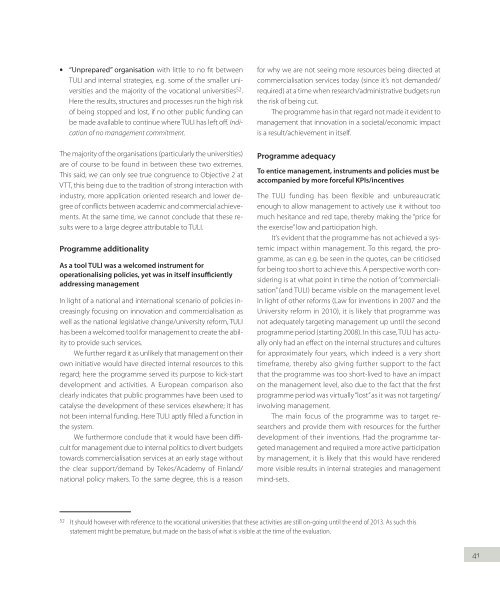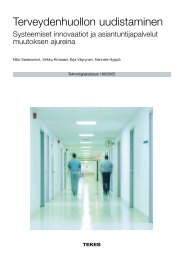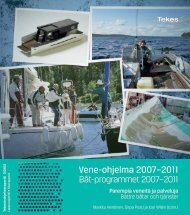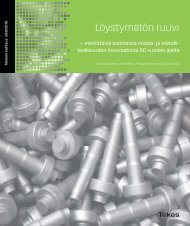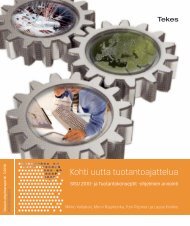Evaluation of TULI Programmes - Tekes
Evaluation of TULI Programmes - Tekes
Evaluation of TULI Programmes - Tekes
You also want an ePaper? Increase the reach of your titles
YUMPU automatically turns print PDFs into web optimized ePapers that Google loves.
••<br />
“Unprepared” organisation with little to no fit between<br />
<strong>TULI</strong> and internal strategies, e.g. some <strong>of</strong> the smaller universities<br />
and the majority <strong>of</strong> the vocational universities 52 .<br />
Here the results, structures and processes run the high risk<br />
<strong>of</strong> being stopped and lost, if no other public funding can<br />
be made available to continue where <strong>TULI</strong> has left <strong>of</strong>f. Indication<br />
<strong>of</strong> no management commitment.<br />
The majority <strong>of</strong> the organisations (particularly the universities)<br />
are <strong>of</strong> course to be found in between these two extremes.<br />
This said, we can only see true congruence to Objective 2 at<br />
VTT, this being due to the tradition <strong>of</strong> strong interaction with<br />
industry, more application oriented research and lower degree<br />
<strong>of</strong> conflicts between academic and commercial achievements.<br />
At the same time, we cannot conclude that these results<br />
were to a large degree attributable to <strong>TULI</strong>.<br />
Programme additionality<br />
As a tool <strong>TULI</strong> was a welcomed instrument for<br />
operationalising policies, yet was in itself insufficiently<br />
addressing management<br />
In light <strong>of</strong> a national and international scenario <strong>of</strong> policies increasingly<br />
focusing on innovation and commercialisation as<br />
well as the national legislative change/university reform, <strong>TULI</strong><br />
has been a welcomed tool for management to create the ability<br />
to provide such services.<br />
We further regard it as unlikely that management on their<br />
own initiative would have directed internal resources to this<br />
regard; here the programme served its purpose to kick-start<br />
development and activities. A European comparison also<br />
clearly indicates that public programmes have been used to<br />
catalyse the development <strong>of</strong> these services elsewhere; it has<br />
not been internal funding. Here <strong>TULI</strong> aptly filled a function in<br />
the system.<br />
We furthermore conclude that it would have been difficult<br />
for management due to internal politics to divert budgets<br />
towards commercialisation services at an early stage without<br />
the clear support/demand by <strong>Tekes</strong>/Academy <strong>of</strong> Finland/<br />
national policy makers. To the same degree, this is a reason<br />
for why we are not seeing more resources being directed at<br />
commercialisation services today (since it’s not demanded/<br />
required) at a time when research/administrative budgets run<br />
the risk <strong>of</strong> being cut.<br />
The programme has in that regard not made it evident to<br />
management that innovation in a societal/economic impact<br />
is a result/achievement in itself.<br />
Programme adequacy<br />
To entice management, instruments and policies must be<br />
accompanied by more forceful KPIs/incentives<br />
The <strong>TULI</strong> funding has been flexible and unbureaucratic<br />
enough to allow management to actively use it without too<br />
much hesitance and red tape, thereby making the “price for<br />
the exercise” low and participation high.<br />
It’s evident that the programme has not achieved a systemic<br />
impact within management. To this regard, the programme,<br />
as can e.g. be seen in the quotes, can be criticised<br />
for being too short to achieve this. A perspective worth considering<br />
is at what point in time the notion <strong>of</strong> “commercialisation”<br />
(and <strong>TULI</strong>) became visible on the management level.<br />
In light <strong>of</strong> other reforms (Law for inventions in 2007 and the<br />
University reform in 2010), it is likely that programme was<br />
not adequately targeting management up until the second<br />
programme period (starting 2008). In this case, <strong>TULI</strong> has actually<br />
only had an effect on the internal structures and cultures<br />
for approximately four years, which indeed is a very short<br />
timeframe, thereby also giving further support to the fact<br />
that the programme was too short-lived to have an impact<br />
on the management level, also due to the fact that the first<br />
programme period was virtually “lost” as it was not targeting/<br />
involving management.<br />
The main focus <strong>of</strong> the programme was to target researchers<br />
and provide them with resources for the further<br />
development <strong>of</strong> their inventions. Had the programme targeted<br />
management and required a more active participation<br />
by management, it is likely that this would have rendered<br />
more visible results in internal strategies and management<br />
mind-sets.<br />
52 It should however with reference to the vocational universities that these activities are still on-going until the end <strong>of</strong> 2013. As such this<br />
statement might be premature, but made on the basis <strong>of</strong> what is visible at the time <strong>of</strong> the evaluation.<br />
41


